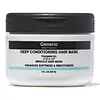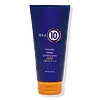What's inside
What's inside
 Key Ingredients
Key Ingredients

 Benefits
Benefits

 Concerns
Concerns

 Ingredients Side-by-side
Ingredients Side-by-side

Water
Skin ConditioningCetyl Alcohol
EmollientGlycerin
HumectantCyclopentasiloxane
EmollientDimethicone
EmollientIsopropyl Palmitate
EmollientBehentrimonium Chloride
PreservativeParfum
MaskingMethyl Gluceth-20
HumectantPrunus Armeniaca Kernel Oil
MaskingPrunus Amygdalus Dulcis Oil
Skin ConditioningKeratin Amino Acids
Skin ConditioningBeta-Glucan
Skin ConditioningLinum Usitatissimum Seed Extract
PerfumingAscorbic Acid
AntioxidantCitric Acid
BufferingSodium Chloride
MaskingHydroxyethylcellulose
Emulsion StabilisingDiazolidinyl Urea
PreservativeMethylparaben
PreservativeEthylparaben
PreservativeTocopheryl Acetate
AntioxidantLinalool
PerfumingBenzyl Salicylate
PerfumingHexyl Cinnamal
PerfumingHydroxycitronellal
PerfumingLimonene
PerfumingCitronellol
PerfumingButylphenyl Methylpropional
PerfumingWater, Cetyl Alcohol, Glycerin, Cyclopentasiloxane, Dimethicone, Isopropyl Palmitate, Behentrimonium Chloride, Parfum, Methyl Gluceth-20, Prunus Armeniaca Kernel Oil, Prunus Amygdalus Dulcis Oil, Keratin Amino Acids, Beta-Glucan, Linum Usitatissimum Seed Extract, Ascorbic Acid, Citric Acid, Sodium Chloride, Hydroxyethylcellulose, Diazolidinyl Urea, Methylparaben, Ethylparaben, Tocopheryl Acetate, Linalool, Benzyl Salicylate, Hexyl Cinnamal, Hydroxycitronellal, Limonene, Citronellol, Butylphenyl Methylpropional
Parfum
MaskingRetinyl Palmitate
Skin ConditioningTocopheryl Acetate
AntioxidantHydrolyzed Collagen
EmollientAloe Barbadensis Leaf Juice
Skin ConditioningPrunus Amygdalus Dulcis Protein
Skin ConditioningHelianthus Annuus Seed Extract
Skin ConditioningCamellia Sinensis Seed Extract
HumectantMethyl Gluceth-20
HumectantDimethicone
EmollientHydrogenated Apricot Kernel Oil
Skin ConditioningSodium Ascorbyl Phosphate
AntioxidantKeratin Amino Acids
Skin ConditioningLinum Usitatissimum Seed Flour
AbrasiveWine Extract
AntioxidantAvena Sativa Kernel Extract
AbrasiveButylene Glycol
HumectantCitric Acid
BufferingSodium Chloride
MaskingPropylene Glycol
HumectantMethylethanolamine
BufferingLinalool
PerfumingHexyl Cinnamal
PerfumingHydroxyisohexyl 3-Cyclohexene Carboxaldehyde
MaskingCadinene
PerfumingBenzyl Benzoate
AntimicrobialParfum, Retinyl Palmitate, Tocopheryl Acetate, Hydrolyzed Collagen, Aloe Barbadensis Leaf Juice, Prunus Amygdalus Dulcis Protein, Helianthus Annuus Seed Extract, Camellia Sinensis Seed Extract, Methyl Gluceth-20, Dimethicone, Hydrogenated Apricot Kernel Oil, Sodium Ascorbyl Phosphate, Keratin Amino Acids, Linum Usitatissimum Seed Flour, Wine Extract, Avena Sativa Kernel Extract, Butylene Glycol, Citric Acid, Sodium Chloride, Propylene Glycol, Methylethanolamine, Linalool, Hexyl Cinnamal, Hydroxyisohexyl 3-Cyclohexene Carboxaldehyde, Cadinene, Benzyl Benzoate
Ingredients Explained
These ingredients are found in both products.
Ingredients higher up in an ingredient list are typically present in a larger amount.
Citric Acid is an alpha hydroxy acid (AHA) naturally found in citrus fruits like oranges, lemons, and limes.
Like other AHAs, citric acid can exfoliate skin by breaking down the bonds that hold dead skin cells together. This helps reveal smoother and brighter skin underneath.
However, this exfoliating effect only happens at high concentrations (20%) which can be hard to find in cosmetic products.
Due to this, citric acid is usually included in small amounts as a pH adjuster. This helps keep products slightly more acidic and compatible with skin's natural pH.
In skincare formulas, citric acid can:
While it can provide some skin benefits, research shows lactic acid and glycolic acid are generally more effective and less irritating exfoliants.
Most citric acid used in skincare today is made by fermenting sugars (usually from molasses). This synthetic version is identical to the natural citrus form but easier to stabilize and use in formulations.
Read more about some other popular AHA's here:
Learn more about Citric AcidDimethicone is a type of synthetic silicone created from natural materials such as quartz.
What it does:
Dimethicone comes in different viscosities:
Depending on the viscosity, dimethicone has different properties.
Ingredients lists don't always show which type is used, so we recommend reaching out to the brand if you have questions about the viscosity.
This ingredient is unlikely to cause irritation because it does not get absorbed into skin. However, people with silicone allergies should be careful about using this ingredient.
Note: Dimethicone may contribute to pilling. This is because it is not oil or water soluble, so pilling may occur when layered with products. When mixed with heavy oils in a formula, the outcome is also quite greasy.
Learn more about DimethiconeHexyl Cinnamal is a fragrance ingredient with a similar scent to jasmine. It can be naturally found in chamomile essential oil.
This ingredient is a known EU allergen and may sensitize the skin. The EU requires this ingredient to be listed separately on an ingredients list.
Hexyl Cinnamal is not water soluble but is soluble in oils.
Learn more about Hexyl CinnamalWe don't have a description for Keratin Amino Acids yet.
Linalool is a fragrance and helps add scent to products. It's derived from common plants such as cinnamon, mint, citrus, and lavender.
Like Limonene, this ingredient oxidizes when exposed to air. Oxidized linalool can cause allergies and skin sensitivity.
This ingredient has a scent that is floral, spicy tropical, and citrus-like.
Learn more about LinaloolMethyl Gluceth-20 is a humectant. Humectants help draw moisture from the air to your skin.
It is created by combining polyethylene glycol with glucose.
Parfum is a catch-all term for an ingredient or more that is used to give a scent to products.
Also called "fragrance", this ingredient can be a blend of hundreds of chemicals or plant oils. This means every product with "fragrance" or "parfum" in the ingredients list is a different mixture.
For instance, Habanolide is a proprietary trade name for a specific aroma chemical. When used as a fragrance ingredient in cosmetics, most aroma chemicals fall under the broad labeling category of “FRAGRANCE” or “PARFUM” according to EU and US regulations.
The term 'parfum' or 'fragrance' is not regulated in many countries. In many cases, it is up to the brand to define this term.
For instance, many brands choose to label themselves as "fragrance-free" because they are not using synthetic fragrances. However, their products may still contain ingredients such as essential oils that are considered a fragrance by INCI standards.
One example is Calendula flower extract. Calendula is an essential oil that still imparts a scent or 'fragrance'.
Depending on the blend, the ingredients in the mixture can cause allergies and sensitivities on the skin. Some ingredients that are known EU allergens include linalool and citronellol.
Parfum can also be used to mask or cover an unpleasant scent.
The bottom line is: not all fragrances/parfum/ingredients are created equally. If you are worried about fragrances, we recommend taking a closer look at an ingredient. And of course, we always recommend speaking with a professional.
Learn more about ParfumChances are, you eat sodium chloride every day. Sodium Chloride is also known as table salt.
This ingredient has many purposes in skincare: thickener, emulsifier, and exfoliator.
You'll most likely find this ingredient in cleansers where it is used to create a gel-like texture. As an emulsifier, it also prevents ingredients from separating.
There is much debate on whether this ingredient is comedogenic. The short answer - comedogenic ratings don't tell the whole story. Learn more about comegodenic ratings here.
The concensus about this ingredient causing acne seems to be divided. Research is needed to understand if this ingredient does cause acne.
Scrubs may use salt as the primary exfoliating ingredient.
Learn more about Sodium ChlorideTocopheryl Acetate is AKA Vitamin E. It is an antioxidant and protects your skin from free radicals. Free radicals damage the skin by breaking down collagen.
One study found using Tocopheryl Acetate with Vitamin C decreased the number of sunburned cells.
Tocopheryl Acetate is commonly found in both skincare and dietary supplements.
Learn more about Tocopheryl Acetate